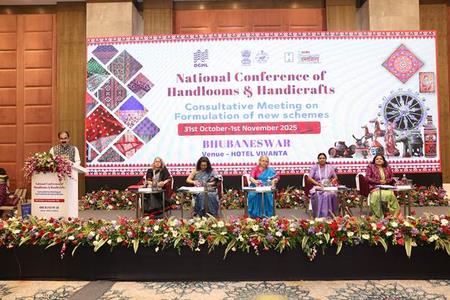
Modern Tools, Productivity In Focus As Experts Discuss Growth Of Handicrafts
Textiles Secretary Neelam Shami Rao emphasised the need to balance the traditional craftsmanship with modern tools to enhance productivity and reduce drudgery.
She stated: "We must safeguard the very ecosystem we are nurturing. Whether we call it handloom or handicraft, it should not be seen as a peripheral part of our economy - it is, in fact, the premium product of the future."
During the event, the Union government reiterated its commitment to re-imagining India's handmade sector as a vital pillar of Viksit Bharat 2047.
Organised by the Offices of the Development Commissioner (Handlooms) and Development Commissioner (Handicrafts), Ministry of Textiles, the two-day conference brought together senior officials from States and Union Territories, policymakers, and sector experts, said a statement.
Deliberations centred around two key objectives: Assessing the current landscape of the handmade economy and shaping the framework of a forthcoming national scheme aimed at deeper State participation, integrated governance, and sustainable sectoral development.
The Textiles Secretary chaired the second day of the conference on Saturday, in the presence of Anu Garg, Additional Chief Secretary and Development Commissioner (Odisha), and Poonam Guha Tapas Kumar, Commissioner-cum-Secretary (Handlooms, Textiles & Handicrafts), Government of Odisha.
Rao urged institutions such as the National Institute of Fashion Technology (NIFT) and the Indian Institute of Handloom Technology (IIHT) to take a proactive role in forecasting design and colour trends ahead of market cycles.
Highlighting the importance of inter-State coordination, she called for seamless movement of raw materials across States to ensure efficient supply chains in the handicrafts sector.
Rao said that such conferences will be organised every six months to ensure continuous dialogue between the Central and State Governments, facilitate cross-learning of best practices, and review the progress of initiatives undertaken in the handloom and handicraft sectors.
She reiterated that sustained coordination and periodic review are essential for achieving the shared vision of a resilient, inclusive, and innovation-driven handmade economy aligned with the goals of Viksit Bharat 2047.
Anu Garg reiterated the cultural and ecological value of handlooms, citing Kotpad and Dongria Shawls as sustainable examples.
She called for greater recognition of artisans (including name-tagging on products), youth-oriented training in market research and product design, and announced plans for a Sustainability Cell and promotion of eco-textiles such as Katha Silk.

Legal Disclaimer:
MENAFN provides the
information “as is” without warranty of any kind. We do not accept
any responsibility or liability for the accuracy, content, images,
videos, licenses, completeness, legality, or reliability of the information
contained in this article. If you have any complaints or copyright
issues related to this article, kindly contact the provider above.














Comments
No comment